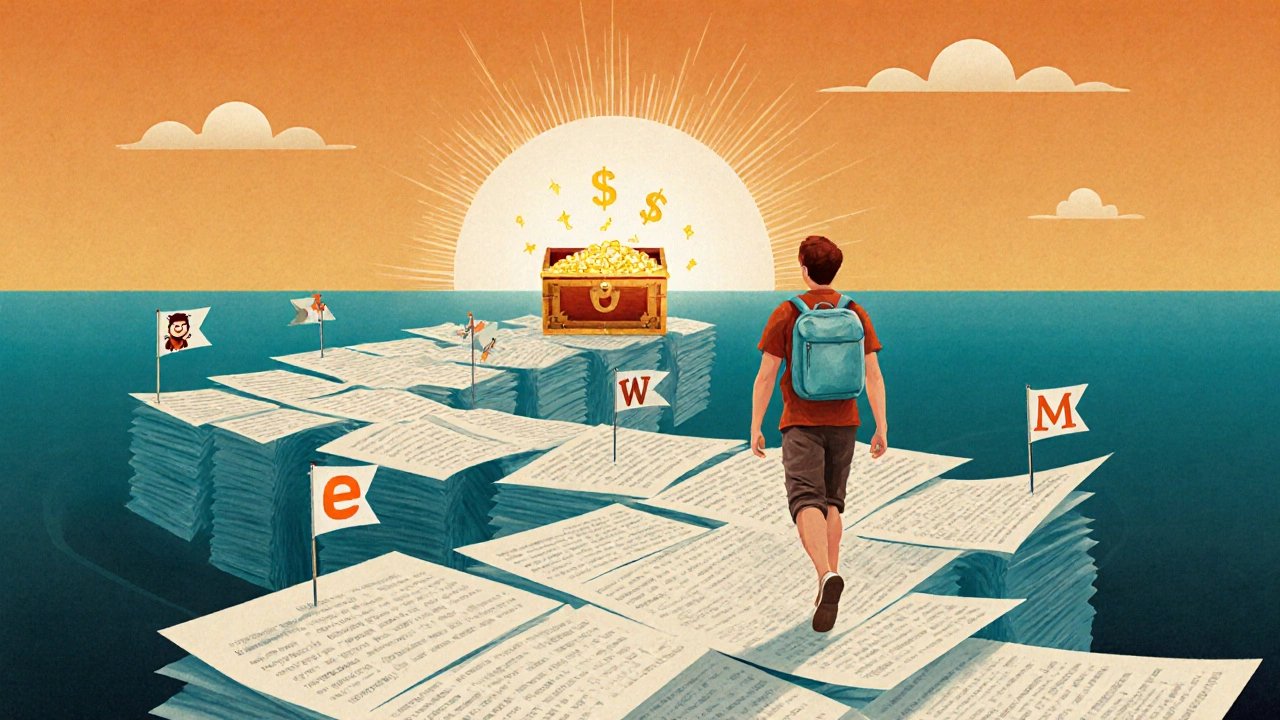Blog Earnings Calculator
How much can you earn?
Estimate potential income based on your blog's traffic and chosen revenue streams
Estimated Earnings
Note: These are conservative estimates based on industry averages. Actual results vary widely based on niche, content quality, and audience engagement.
Blogging is a digital activity where individuals publish articles, stories, or opinions on the web to attract readers and build a community. Many wonder whether the time spent typing away on a free site actually translates into cash. The short answer: it can, but only if you treat your blog like a small business rather than a hobby.
How money flows into a blog
There are six proven avenues that turn page views into pennies, then dollars.
- Display ads - networks such as Google AdSense place banner or native ads on your pages and pay per click or thousand impressions.
- Affiliate marketing - you recommend a product, embed a tracking link, and earn a commission when a reader buys through it.
- Sponsored content - brands pay you to write a review or mention their service.
- Digital products - e‑books, printables, online courses, or photo packs can be sold directly from the blog.
- Memberships or subscriptions - platforms like Substack let readers pay a monthly fee for premium posts.
- Services - consulting, freelance writing, or coaching booked via a contact form.
Each method has its own revenue curve. Ads usually trickle in slowly, while a well‑priced e‑book can spike earnings in a single week.
What real bloggers earn
Data from the 2024 Blog Income Survey (1,200 respondents) shows a wide spread:
- 10% of bloggers earn under $100 per month - typically newcomers with <1000 monthly visitors.
- 45% fall in the $100‑$500 bracket - they run a handful of affiliate links and modest ad revenue.
- 30% make $500‑$2,000 - they combine multiple streams, often with a niche audience.
- 15% break $2,000 - these are the specialists who sell courses or have high‑ticket sponsorships.
The median income is about $250 a month. That number sounds low, but remember many bloggers treat it as supplemental income while keeping a day job.
Free blogging platforms and their monetization rules
If you start on a free platform, you inherit its policies. Some sites let you run ads right away, others block any revenue until you upgrade.
| Platform | Ad support | Affiliate links | Paid upgrades needed | Best for |
|---|---|---|---|---|
| WordPress.com | Only via WordPress.com Premium or Business plan | Allowed on Premium+ plans | Upgrade to Premium for $8/mo or Business for $25/mo | Flexible design, easy migration |
| Blogger | Google AdSense supported on any free blog | Allowed | None - fully free | Simple setup, good for beginners |
| Medium | Medium Partner Program shares subscription revenue | Limited - external links allowed but no direct affiliate commissions | None for basic publishing, Partner Program sign‑up required | Story‑focused audience, clean UI |
| Substack | Subscription fees (no ads) | Allowed in newsletters, but not as primary revenue | None - platform takes 10% fee | Newsletter‑first creators |
| Wix | AdSense integration on free plan (limited impressions) | Allowed | Upgrade to Combo or Unlimited for full control | Visually rich sites, drag‑and‑drop |
Notice how only Blogger lets you earn from ads without paying a fee. If you’re serious about blog monetization, you’ll likely need to budget for a low‑cost upgrade.
Turning a free blog into a revenue machine - step‑by‑step checklist
- Pick a niche that solves a specific problem. Example: “budget travel for digital nomads”.
- Choose a platform that matches your monetization plan. If you want AdSense now, start on Blogger.
- Set up essential SEO basics - a clear title tag, meta description, and URL structure.
- Create pillar content (3‑5 long‑form posts of 1,500+ words) that target high‑search‑volume keywords.
- Insert one affiliate link per post, naturally woven into the story.
- Apply for an ad network once you have at least 5,000 monthly page views.
- Launch a lead magnet (free checklist or mini‑e‑book) to collect email addresses.
- Send a weekly newsletter that promotes a low‑ticket product or affiliate deal.
- Track earnings and traffic in a spreadsheet; adjust tactics every month.

Common pitfalls and how to dodge them
Pitfall #1: Chasing traffic without a monetization route. You can get 10,000 visitors a month, but if the platform bans ads, you’ll earn nothing. Pick a platform that aligns with your income strategy from day one.
Pitfall #2: Overloading posts with affiliate links. Readers spot spam and bounce. Keep the ratio to one link per 300 words and disclose transparently.
Pitfall #3: Ignoring mobile users. Over 60% of blog traffic now comes from phones. Choose a responsive theme and test load times with Google PageSpeed.
Pitfall #4: Forgetting to diversify. Relying solely on AdSense can dry up if CPC drops. Mix in digital products or memberships for stability.
Quick FAQ
Can I earn money on a completely free blog?
Yes, but options are limited. Blogger lets you place AdSense ads without paying, while Medium’s Partner Program shares subscription revenue. For affiliate links you can use any free platform, but you’ll need traffic to see income.
How long does it take to see the first $100?
Most creators report 3‑6 months of consistent posting before breaking $100, assuming they have at least 2,000 monthly visitors and at least one affiliate link per post.
Is it better to start on a free platform or a self‑hosted site?
Self‑hosted WordPress gives full control over ads, plugins, and custom checkout tools, but costs $3‑5/month for hosting. Free platforms have zero upfront cost but restrict many monetization methods. If you’re testing the waters, start free and migrate once you hit 5,000 monthly views.
What are the safest affiliate programs for beginners?
Amazon Associates, ShareASale, and CJ Affiliate are popular because they approve most niches and pay reliably. Choose programs that align with your blog’s topic to keep recommendations authentic.
Do I need a separate business bank account?
When earnings exceed $600 in a year, the IRS requires a Schedule C form. Opening a dedicated account helps track income, simplifies tax filing, and looks more professional to sponsors.
Bottom line: blogging can pay, but the payoff depends on niche choice, traffic, and the freedom your platform gives you to monetize. Start small, upgrade strategically, and treat each post like a mini‑sales page.
